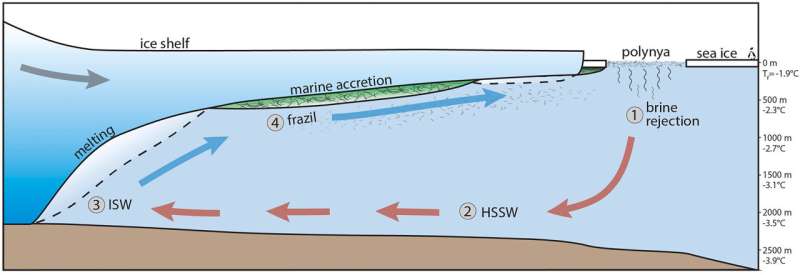This article has been reviewed according to Science X's editorial process and policies. Editors have highlighted the following attributes while ensuring the content's credibility:
fact-checked
peer-reviewed publication
trusted source
proofread
Ice shell thickness reveals water temperature on ocean worlds

Decades before any probe dips a toe—and thermometer—into the waters of distant ocean worlds, Cornell astrobiologists have devised a novel way to determine ocean temperatures based on the thickness of their ice shells, effectively conducting oceanography from space.
Available data showing ice thickness variation already allows a prediction for the upper ocean of Enceladus, a moon of Saturn, and a NASA mission's planned orbital survey of Europa's ice shell should do the same for the much larger Jovian moon, enhancing the mission's findings about whether it could support life.
The researchers propose that a process called "ice pumping," which they've observed below Antarctic ice shelves, likely shapes the undersides of Europa's and Enceladus's ice shells, but should also operate at Ganymede and Titan, large moons of Jupiter and Saturn, respectively.
They show that temperature ranges where the ice and ocean interact—important regions where ingredients for life may be exchanged—can be calculated based on an ice shell's slope and changes in water's freezing point at different pressures and salinities.
"If we can measure the thickness variation across these ice shells, then we're able to get temperature constraints on the oceans, which there's really no other way yet to do without drilling into them," said Britney Schmidt, associate professor of astronomy and of Earth and atmospheric sciences in the College of Arts and Sciences and Cornell Engineering. "This gives us another tool for trying to figure out how these oceans work. And the big question is, are things living there, or could they?"
With current and former members of her Planetary Habitability and Technology Lab, Schmidt, who is a member of NASA's Europa Clipper science team, is a co-author of "Ice-Ocean Interactions on Ocean Worlds Influence Ice Shell Topography," published in the Journal of Geophysical Research: Planets. The first author is Justin Lawrence, visiting scholar at the Cornell Center for Astrophysics and Planetary Science (A&S) and a program manager at Honeybee Robotics.
In 2019, using the remotely operated Icefin robot, Schmidt's team, including Lawrence, observed ice pumping inside a crevasse beneath Antarctica's Ross Ice Shelf. Smooth and cloudy meteoric ice at the shelf's base melted, producing fresher, less dense water that rose up the crevasse and refroze as rough, green marine ice. Results were reported in Nature Geoscience and Science Advances, in papers led by Lawrence and Peter Washam, research scientist in the Department of Astronomy (A&S).
The process is driven by the fact that water's freezing point negatively depends on pressure: As depth and pressure increase, water must be colder to expand and freeze. Deep down, where pressure is greater and the freezing point colder, ocean currents can melt ice more easily. If the melted ice water is buoyant and upwells to shallower depths and lower pressure, it will freeze again. The cycle redistributes some ice within a shelf or shell, changing its composition and texture.
"Anywhere you have those dynamics, you would expect to have ice pumping," Lawrence said. "You can predict what's going on at the ice-ocean interface based on the topography—where the ice is thick or thin, and where it is freezing or melting."
The researchers mapped ranges of potential shell thickness, pressure, and salinity for ocean worlds with varying gravity and concluded that ice pumping would occur in the most probable scenarios, though not in all. They found that ice-ocean interactions on Europa may be similar to those observed beneath the Ross Ice Shelf—evidence, Lawrence said, that such regions may be some of the most Earth-like on alien worlds.
NASA's Cassini probe generated data sufficient to predict a temperature range for Enceladus's ocean based on the slope of its ice shell from poles to equator: minus 1.095 degrees to minus 1.272 degrees Celsius. Knowing temperatures informs understanding of how heat flows through oceans and how they circulate, affecting habitability.
The researchers expect ice pumping to be weak at Enceladus, a small moon (the width of Arizona) with dramatic topography, while at larger Europa—nearly the size of Earth's moon—they predict it acts quickly to smooth and flatten the ice shell's base.
Schmidt said the work demonstrates how research investigating climate change on Earth can also benefit planetary science, a reason NASA has supported Icefin's development.
"There's a connection between the shape of the ice shell and the temperature in the ocean," Schmidt said. "This is a new way to get more insight from ice shell measurements that we hope to be able to get for Europa and other worlds."
More information: J. D. Lawrence et al, Ice‐Ocean Interactions on Ocean Worlds Influence Ice Shell Topography, Journal of Geophysical Research: Planets (2024). DOI: 10.1029/2023JE008036
Journal information: Journal of Geophysical Research: Planets , Nature Geoscience , Science Advances
Provided by Cornell University



















